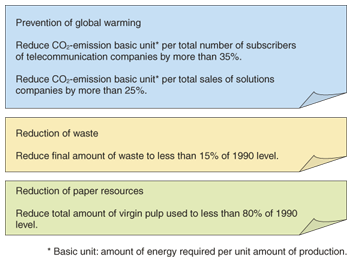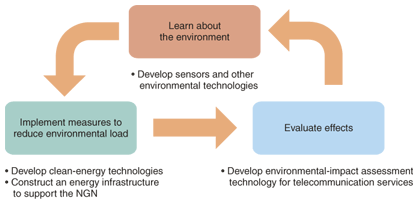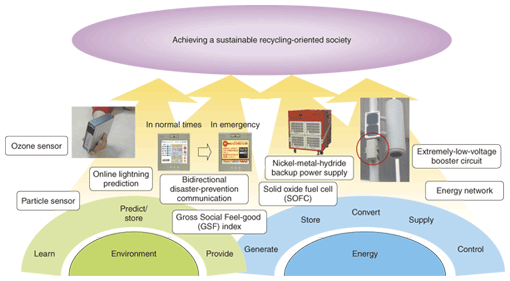 |
|||||||||||||||||||
|
|
|||||||||||||||||||
|
Special Feature: NTT Technologies for the Environment and a Safe and Secure Society Vol. 6, No. 2, pp. 6–10, Feb. 2008. https://doi.org/10.53829/ntr200802sf1 Developing Technologies for the Environment and a Safe and Secure SocietyAbstractAs concern about global warming and other environment problems grows, researchers at NTT Energy and Environment Systems Laboratories are researching and developing technologies to support the environment and promote a safe and secure society. This article outlines the work of these laboratories from four main perspectives including the development of environmental and clean-energy technologies to enable people to lead safe and secure lives.
1. NTT Group's environmental protection measuresIn addition to environmental changes on a global scale, such as the worldwide rise in average temperature and shrinking of the Arctic ice-cap, local manifestations of global warming can be seen in Japan with the recent breaking of a 74-year-old record for the highest recorded temperature. Amidst these developments, the first commitment period (2008–2012) of the Kyoto Protocol is due to begin next year, and Japan has committed to a cut in greenhouse-gas emissions (six types including CO2 and NO) of 6% from 1990 levels [1], [2]. Deciding on global warming measures has become an important issue in society. The NTT Group has established targets for major action plans (2010), as shown in Fig. 1, as part of its environmental protection activities, which include global warming measures and waste reduction. It is also participating in the Keidanren (Japan Business Federation) Voluntary Action Plan on the Environment and issuing progress reports.
2. In support of the environment and safety and securityAs its name implies, NTT Energy and Environment Systems Laboratories promotes the development of technologies in the two areas of energy and the environment. It does not restrict itself to environmental problems on a global scale such as the prevention of global warming, but also aims to create enriching, safe, and secure lifestyles for everyone and a secure recycling-oriented society with a low environmental load (Fig. 2). To this end, an accurate understanding of the environment must first be obtained in the form of tangible information. Next, measures for achieving specific reductions of the environmental load must be implemented based on that environmental information. And finally, the effect of those measures must be appropriately evaluated (Fig. 3). In accordance with this cycle, research and development at NTT Energy and Environment Systems Laboratories is moving forward from the following four perspectives (Fig. 4). (1) Developing sensors and other environmental technologies
(2) Developing clean-energy technologies (3) Constructing an energy infrastructure to support the next-generation network (NGN) (4) Developing environmental-impact assessment technology for telecommunication services
2.1 Developing sensors and other environmental technologiesThere are three phases to environmental technology: (1) the development of sensors to learn about the environment, (2) the development of information-collecting-and-processing technology for making predictions about the environment based on sensor data, and (3) the development of information-provision technology for providing users with environment-related information. Two examples of our work in sensor development are ozone sensors (samplers) and particle sensors. Ozone sensors indicate the amount of ozone that the user is being exposed to through a simple change in color. This feature can be applied to diverse applications such as safety measures for workers in food processing plants and sewage processing facilities. The third article in this Special Feature introduces a color sensor network that uses such color-change sensors to detect ozone [3]. Particle sensors, on the other hand, can measure the number of suspended particles in the atmosphere from the degree of laser-light scattering. This feature can be used for monitoring atmospheric pollution and ensuring worker safety in a mine environment. Next, information-collecting-and-processing technology that we have developed includes environmental image processing for making detailed temporal and spatial analyses of camera and radar images and predicting meteorological phenomena such as thunderclouds [4] and tornados. This technology should make it possible to accurately predict near-term climate change, and in this role, it is expected to be applied to disaster prevention. Finally, an example of our work in the development of information-provision technology is a bidirectional disaster-prevention communication system using Flet's Phones (tablet videophones) [5] connected to the IP (Internet protocol) network. During normal times of operation, this system would be used mainly for disseminating information from local governments and other institutions, but at the time of a disaster, it could be used to deliver disaster-related information such as details about emergency evacuation to local residents while also enabling residents themselves to report their safety status to local authorities. It could thus be used to expedite rescue efforts during a natural disaster. Its effectiveness is being demonstrated in verification experiments that are currently being conducted in the town of Tsunan in Niigata prefecture. 2.2 Developing clean-energy technologiesEnergy technologies can be divided into the five fields of generation, storage, conversion, supply, and control. NTT Energy and Environment Systems Laboratories is researching and developing technology in each of these fields. In the field of power generation, we are developing highly efficient solid oxide fuel cells (SOFC). Fuel cells such as these are attracting attention as a clean source of energy because they emit little CO2. NTT is committed to developing high-efficiency, large-capacity fuel cells for both the commercial market and for its own telecommunication systems. The fourth article introduces NTT's research and development on solid oxide fuel cells [6]. In the field of storage, we are developing backup power-supply systems using nickel-metal-hydride batteries. More details are given in the next article in this Special Feature [7]. Compared with existing backup power-supply systems, these systems provide backup for a long period, have a compact and lightweight configuration, and feature a design that solves past problems of noise and fumes. These environment-friendly power supplies can be used at railroad crossings to ensure safety at the time of a disaster. Next, in the field of conversion, we have developed an autonomous power supply for outdoor equipment using extremely-low-voltage booster circuit technology. This circuit (capable of boosting a voltage of about 0.1 V to 5 V) eliminates the need to connect solar cells in series, so it eliminates the usual drawback that no power is generated when even 5% of the cells are in the shade. The developed booster circuit can supply power without interruption. This autonomous power supply system can be applied, for example, to outdoor monitoring cameras installed along rivers for disaster-prevention purposes. Finally, in the field of control, we are researching energy networks with the aim of reducing CO2 emissions. We plan to network distributed power-supply systems such as solar power generators and fuel cells with commercial power supplies and optimize the supply of power to each service area. 2.3 Constructing an energy infrastructure to support the NGNNTT is moving forward with the construction of an NGN to provide a network environment that enables users to access a large number and variety of communication services whenever and wherever desired. To supply power safely and efficiently with high reliability in the face of increasing traffic in the NGN, we are researching and developing an energy infrastructure including the development of new types of fuses. 2.4 Developing environmental-impact assessment technology for telecommunication servicesReducing CO2 emissions and the environmental load in general is part of our efforts to fulfill our corporate social responsibility (CSR). It is therefore important that we have a means of quantitatively evaluating the effects of our efforts. NTT has developed an environmental-impact assessment system for information-communication services that has been in operation since October 2005. This system was originally developed to compare environmental load (in terms of the amount of CO2 emissions associated with manufacturing, use, and disposal) when using information and communication technology (ICT) with that of conventional services (comparing, for example, email with the postal service). At present, we are investigating a Gross Social Feel-good (GSF) index [8] that adds aspects like human health, safety, and economy to the environmental load to assess the sustainability of ICT services. 3. Future outlookIn addition to promoting research and development in the energy field toward global environment protection, NTT Energy and Environment Systems Laboratories will continue to develop technologies like environmental sensing and environmental prediction that help to improve the environment around people and society. We also wish to contribute to the creation of a sustainable recycling-oriented society through the development of technologies that support the environment and promote a safe and secure society. References
|
|||||||||||||||||||












